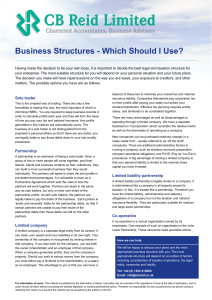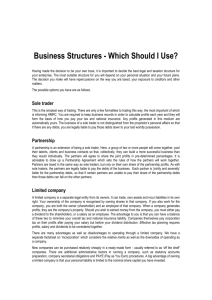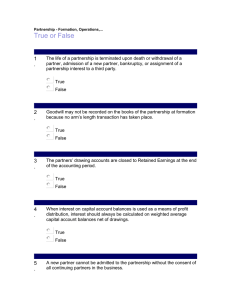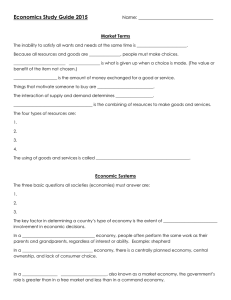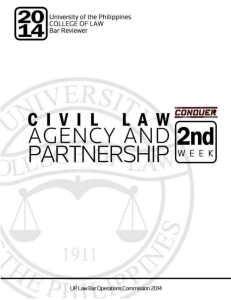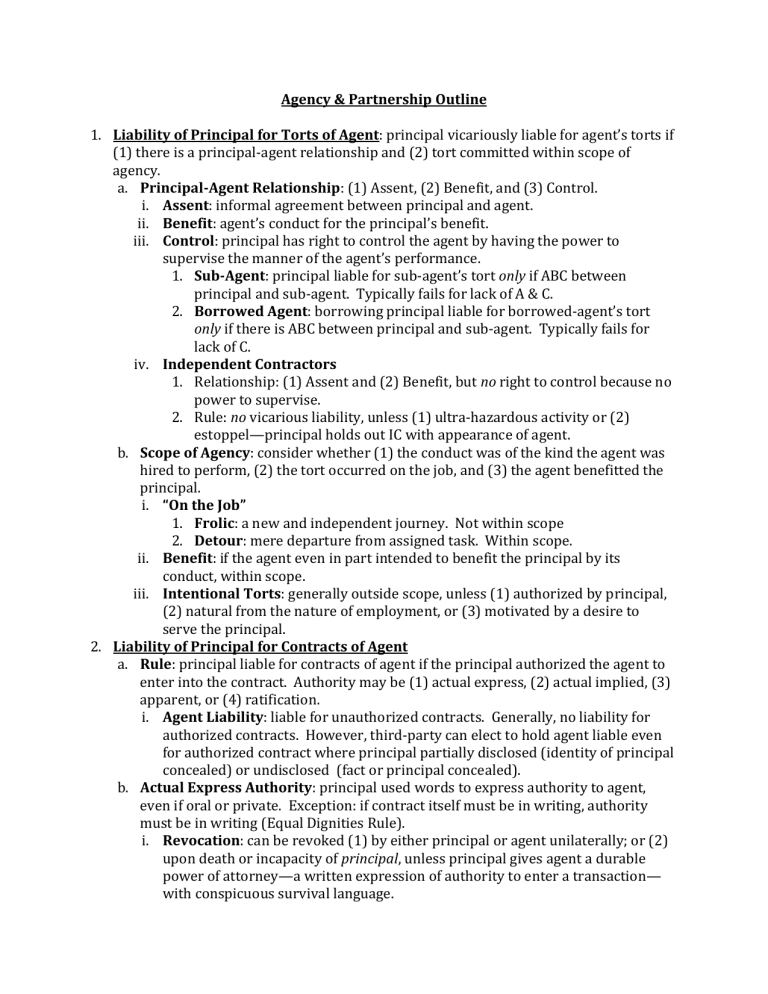
Agency & Partnership Outline 1. Liability of Principal for Torts of Agent: principal vicariously liable for agent’s torts if (1) there is a principal-agent relationship and (2) tort committed within scope of agency. a. Principal-Agent Relationship: (1) Assent, (2) Benefit, and (3) Control. i. Assent: informal agreement between principal and agent. ii. Benefit: agent’s conduct for the principal’s benefit. iii. Control: principal has right to control the agent by having the power to supervise the manner of the agent’s performance. 1. Sub-Agent: principal liable for sub-agent’s tort only if ABC between principal and sub-agent. Typically fails for lack of A & C. 2. Borrowed Agent: borrowing principal liable for borrowed-agent’s tort only if there is ABC between principal and sub-agent. Typically fails for lack of C. iv. Independent Contractors 1. Relationship: (1) Assent and (2) Benefit, but no right to control because no power to supervise. 2. Rule: no vicarious liability, unless (1) ultra-hazardous activity or (2) estoppel—principal holds out IC with appearance of agent. b. Scope of Agency: consider whether (1) the conduct was of the kind the agent was hired to perform, (2) the tort occurred on the job, and (3) the agent benefitted the principal. i. “On the Job” 1. Frolic: a new and independent journey. Not within scope 2. Detour: mere departure from assigned task. Within scope. ii. Benefit: if the agent even in part intended to benefit the principal by its conduct, within scope. iii. Intentional Torts: generally outside scope, unless (1) authorized by principal, (2) natural from the nature of employment, or (3) motivated by a desire to serve the principal. 2. Liability of Principal for Contracts of Agent a. Rule: principal liable for contracts of agent if the principal authorized the agent to enter into the contract. Authority may be (1) actual express, (2) actual implied, (3) apparent, or (4) ratification. i. Agent Liability: liable for unauthorized contracts. Generally, no liability for authorized contracts. However, third-party can elect to hold agent liable even for authorized contract where principal partially disclosed (identity of principal concealed) or undisclosed (fact or principal concealed). b. Actual Express Authority: principal used words to express authority to agent, even if oral or private. Exception: if contract itself must be in writing, authority must be in writing (Equal Dignities Rule). i. Revocation: can be revoked (1) by either principal or agent unilaterally; or (2) upon death or incapacity of principal, unless principal gives agent a durable power of attorney—a written expression of authority to enter a transaction— with conspicuous survival language. 3. 4. 5. 6. c. Actual Implied Authority: authority through conduct or circumstances. i. Necessity: implied authority to do anything necessary to accomplish an expressly authorized task. ii. Custom: implied authority to do anything customarily performed by persons with the agent’s title or position. iii. Prior Acquiescence by Principal: implied authority to do anything which the agent believes to have been authorized from the principal’s prior acquiescence. d. Apparent Authority: authority exists where (1) principal cloaked agent with the appearance of authority, and (2) third-party reasonably relies on appearance of authority. e. Ratification: authority can be granted after the contract if principal (1) has knowledge of all material facts of contract and (2) accepted benefits of contract. However, ratification must be complete—cannot pick and choose contract’s terms. Duties Agents Owe to Principals a. Duties: in return for reasonable compensation and reimbursement of expenses, agents owe (1) duty of care, (2) duty to obey reasonable instructions, and (3) duty of loyalty. Agent cannot: engage in self-dealing, usurp the principal’s opportunity, or earn secret profits (profits at principle’s expense without disclosure). b. Remedies: principal may recover losses caused by breach and disgorge profits. General Partnership Formation: a GP is an association of 2 or more persons who are carrying on as co-owners of a business for profit. No formalities are required. Key factor is sharing of profits. Therefore, the contribution of money or services in return for a share of profit—not salary or loan interest—creates a presumption that GP exists. Liabilities of General Partners to 3rd Parties a. Liability of General Partnership: Agency Principles Apply: partners are agents of partnership for carrying on usual partnership business. Thus, general partnership liable for each partner’s torts in the scope of partnership business and for each partner’s authorized contracts, unless third-party had notice of lack of authority. b. Liability of Each General Partner: each personally liable for all debts of the partnership and for each co-partner’s torts. i. Incoming Partner Liability for Pre-Existing Debt: generally not liable, but any money paid in to partnership by incoming partner can be used to satisfy prior debts. ii. Dissociating Partner Liability for Subsequent Debts: retains liability on future debts until (1) actual notice of dissociation given to creditors or (2) 90 days after filing notice of dissociation with state. c. General Partnership Liability by Estoppel: one who represents to a 3rd party that a GP exists will be liable as if a GP exists. Rights & Liabilities Among General Partners a. Fiduciary Duties: general partners are fiduciaries of each other and of the GP. May never engage in self-dealing, usurpation of partnership opportunity, or secret profit. Remedy: action for accounting. GP can recover losses causes by partner’s breach and disgorgement of profits. b. Partners’ Rights in Partnership Property & Liquidity i. Specific Partnership Assets: e.g., land, leases, equipment owned by the partnership. May not be transferred by individual partners without partnership authority. Hint: to determine ownership, look to whose money was used to purchase item: if personal, likely personal, if partnership, likely partnership. ii. Share of Profits: personal property of partner and may be transferred. iii. Share in Management: asset owned only by partnership itself, and therefore cannot be transferred. c. Management: absent agreement (which they may freely do), each partner is entitled to equal control (vote) in management, regardless of share in profits. For ordinary course decision, majority controls, but for matters outside ordinary course, unanimity required. One partner cannot unilaterally limit another’s equal power—there must be a management agreement that does so, and third-parties not bound unless a statement of limitation of authority is filed with the state. d. Salary: absent agreement, partners get no salary. However, partners receive compensation for one thing: helping to wind up partnership business. e. Partners’ Share of Profits & Losses i. Profits: absent agreement, shared equally. Agreement on losses has no effect. ii. Loss: absent agreement, shared like profits. Thus, could be shared per agreement on profits, even if agreement doesn’t mention losses. 7. General Partnership Dissolution a. Process. First, Dissolution—in the absence of an agreement that sets forth events of dissolution, a GP dissolves upon notice (written or oral) of the express will of just 1 general partner to dissociate. Second, Winding Up—period between dissolution and termination in which remaining partners liquidate the partnership’s assets to satisfy partnership creditors. Finally, Termination—end of partnership. b. Partnership’s Liability i. Old Business: partnership (and each partner) still liable on all transactions entered into to wind up old business in order to satisfy existing creditors. ii. New Business: only permissible new business is that to wind up partnership. However, for any act, partnership (and each partner) still liable on new contracts until actual notice of dissolution is given to creditors or until 90 days after filing statement of dissolution with state. c. Priority of Distribution: each level of priority must be fully satisfied before next: i. Creditors: must pay all creditors, including all partners who have loaned money to the partnership. ii. Capital Contributions by Partners: must fully repay capital contributions. iii. Profits, if any, shared equally unless agreement otherwise. Rule: if partnership does not have enough to pay i. or ii., individual general partners must contribute fair share of funds (even individual partner owed money thereunder)—under usual formula for profits and losses, unless agreement. 8. Alternative Unincorporated Business Organizations a. Limited Partnerships: a partnership with at least 1 general and 1 limited partner. i. Formation: must file Limited Partnership Certificate that includes names of all general partners. ii. Liability & Control 1. General Partners: liable for all LP obligations, but have a right to manage the business. 2. Limited Partners: not liable for the LP’s obligations. For control, the law in most states and in CA is still that a limited partner may not manage the business without forfeiting limited liability. But, under the newly-revised Uniform Limited Partnership Act, may manage without forfeiting. b. Registered Limited Liability Partnership (RLLP) i. Formation: register by filing a Statement of Qualification and annual reports. ii. Liabilities: no partner, not even general partners, are liable for debts of RLLP. c. Limited Liability Company (LLC): a hybrid between a corporation and a partnership, in which owners—members—have the same limited liability as shareholders in a corporation and also the benefits of partnership tax treatment. i. Formation: must file Articles of Organization and may adopt an operating agreement. ii. Control: members may control the business, but may also delegate control to a team of managers. iii. Limited Liquidity: a full membership interest may not be transferred without unanimous consent of the members or as provided in the operating agreement. iv. Limited Life: company will dissolve upon unanimous consent of members or as provided in the operating agreement.



